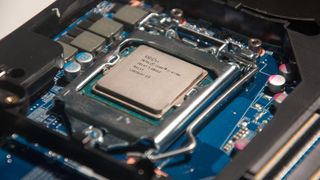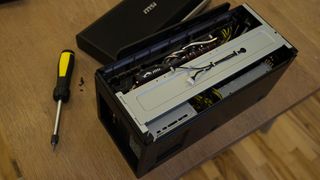
When it comes to gaming laptops, desktop performance has always been the measuring stick to which gamers hope mobile gaming will finally reach. Now with this year's crop of gaming laptops, we've seen greater mobile computing performance is finally obtainable thanks to the introduction of desktop parts working in tandem with laptop components.
Two machines that best represent this are the Origin EON15-X and MSI GS30 Shadow with GamingDock. The former comes equipped with a desktop processor packed into a 1.5-inch chassis. Meanwhile, the MSI GS30 links up with a desktop GPU box via a port at the back of the notebook.
The two are similar in that they utilize desktop components to achieve a higher level of performance beyond even the most decked-out mobile gaming rig. However, with Intel's Broadwell CPU and Nvidia's Maxwell GPU raising the bar for notebook performance,, is the desktop still really that much farther ahead than laptop components?
We're going to examine just how much more power you get out of desktop components over their mobile equivalents and determine which are truly the best for gaming.

CPU or GPU
For starters, this isn't a race that will end with one prize pony coming in first. It's a bit more complicated because the processor and graphics card are used to perform completely different but connected processes.
The CPU is in charge of basic computing tasks, like running your basic PC environment for email and file management. While gaming, the processor also serves a larger role in running all the calculations needed for a game to run from player movement to the physics of every virtual detail.
For role playing games, the CPU is also extremely important to power all the in-game artificial intelligence for non-playable characters. What's more, real-time strategy games require significant computing power to churn through tons of equations including rule sets, the movement path of units and the calculations of AI-driven decisions.
Get daily insight, inspiration and deals in your inbox
Get the hottest deals available in your inbox plus news, reviews, opinion, analysis and more from the TechRadar team.
The graphics card meanwhile is tasked with generating visuals and draws the scene in games. This includes loading and rendering textures, which it then processes into one seamless picture. While this might sound like slightly less taxing work, the GPU is equipped with thousands of small cores designed to handle multiple tasks simultaneously.

While the CPU and GPU components handle different tasks, neither can stand without the other. The CPU creates the underlying framework of a game and tells the GPU what it needs to render in order to create a visual world since it's not designed to do it on it own.
Kevin Lee was a former computing reporter at TechRadar. Kevin is now the SEO Updates Editor at IGN based in New York. He handles all of the best of tech buying guides while also dipping his hand in the entertainment and games evergreen content. Kevin has over eight years of experience in the tech and games publications with previous bylines at Polygon, PC World, and more. Outside of work, Kevin is major movie buff of cult and bad films. He also regularly plays flight & space sim and racing games. IRL he's a fan of archery, axe throwing, and board games.

